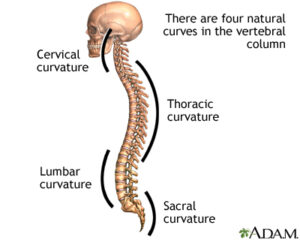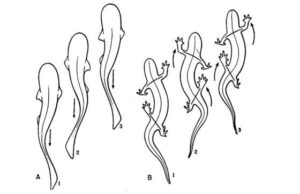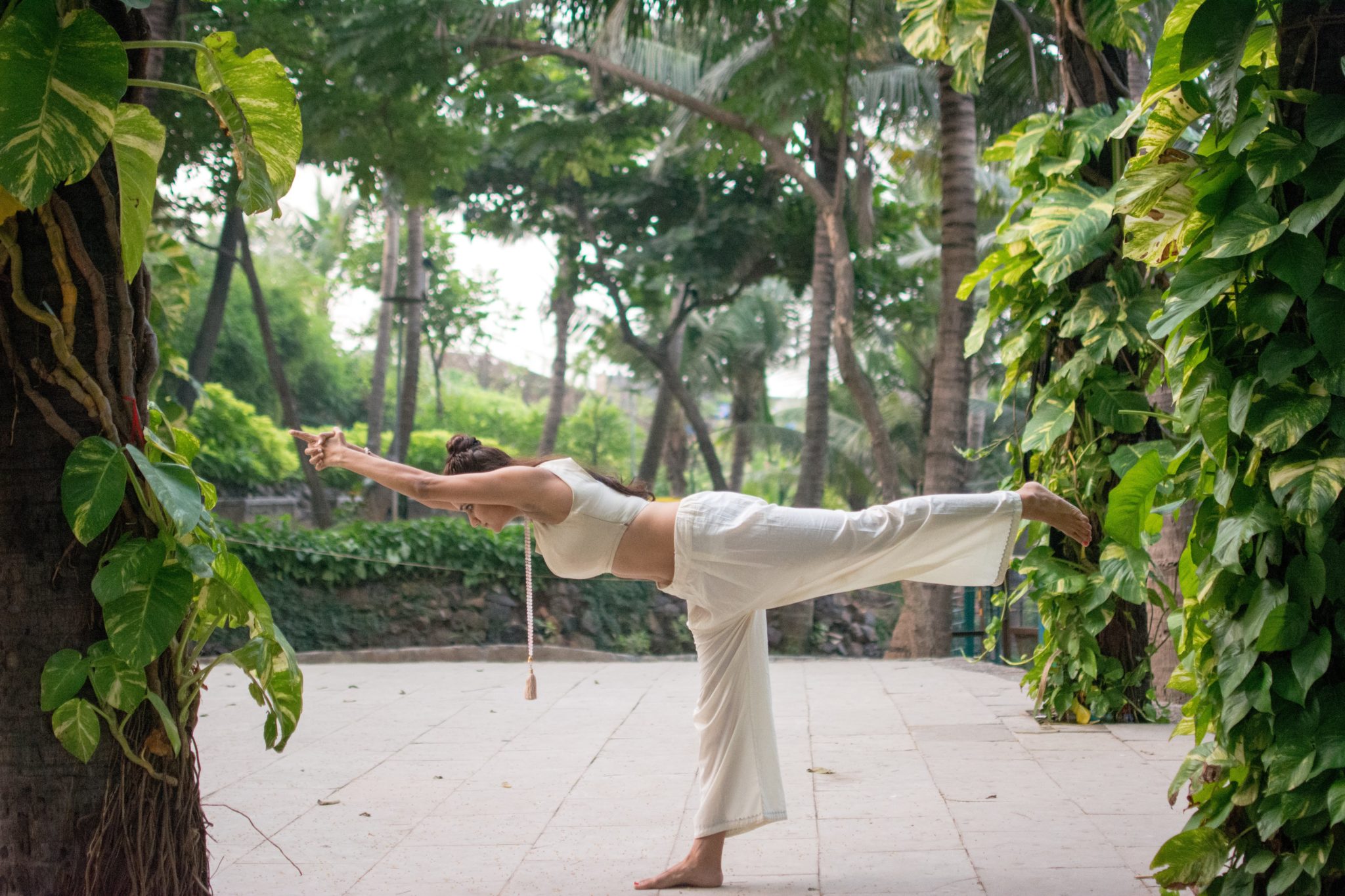Recently I was at a family dinner with two adorable bumbling kids – the little girl was excitedly telling me all that she had learnt about respiration at school when suddenly her adorable younger brother bellowed at all the elders “elbows off the table please” – you see, he’d just learnt it in school. And as the ‘elders’ complied with the orders, they all invariably had to straighten up to be able to eat the food gracefully. This charming reiteration of table manners by an 8-year-old is not a matter of aesthetics but is a significant matter of our anatomy. We keep elbows off the table because to do that you need to have a great posture or in other words a strong spine.
In evolutionary terms, it is our unique posture with an upright spine that set the stage for us to become human. This was facilitated by the development of a unique curve called the Lumbar curve or in simpler terms, our lower back. This was the critical evolutionary breakthrough which made us the only beings on the planet that could walk (exclusively) on two feet ~ our distinctly human quality.
With a straight spine we could walk and use our hands for other skills like building tools, which created abundance of food and the need for sharing it so we could in turn partake from others when we had a rainy day. The dynamics of social interaction (need to identify free loaders among other things ) led to our brains getting sharper and smarter so we could be more successful and survive by forging new relationships.
In fact, it was the lack of these social skills that the Neanderthals were wiped out even though they were perhaps as smart as homo sapiens. It had long been believed that Neanderthals didn’t survive because they were dim witted, but a research study lead by Professor Dan Adler discovered that the actual reason for their failure was lack of social skills. Since they did not socialize and lived in isolated groups, they could not leverage group dynamics for survival. Whereas modern humans were more mobile, traveled longer distances, made friends and helped each other out.
What is interesting is that the Neanderthals could do anything that humans could, some lived in house like structures, buried the dead with flowers, they were structurally stronger, made the same tools, hunted the same animals, could control fire and understood technique and behavior just as well. But they differed from us in one unique way – the lumbar curve in the spine of Neanderthals was the exact opposite of humans. And clearly, that didn’t work in favor of their survival.
Our spines also help us maintain a horizontal gaze and look people in the eye while interacting thus enabling stronger social bonds. Robert Dunbar a Psychologist at Oxford University believes that human brain became bigger as the social groups got larger. He observed that the larger the group size of a species, the bigger was its brain. Yet another study recently finds a strong correlation even between the amount of gray matter and well, the size of someone’s social network or the number of Facebook friends! But there was one big evolutionary event that happened before we became smart or social and that was the straightening up of our spine. This single event differentiated us from all the other species and is a trait that remains unique to us.
This development was so significant that it can be said that the evolutionary success of our species is largely due to two reasons and in this order –
• Unique curved spines
• Large intricate brains

We started with a flat spine as sea creatures, an arched spine (thoracic curve) as amphibious reptiles, gained another curve (cervical) to balance our neck and finally we became human as we gained a lumbar curve in the lower back to stand up straight.
It was earlier believed that the big size of our brains is what distinguished us from apes in evolutionary history. But later studies revealed that it is was the ability to walk standing up on two feet, that first separated us from other primates. The ability to stand upright and balance a very heavy head precariously on top of the spine was a marvel of organic engineering that eventually led to the development of a larger brain.
The evolution of our spines left our hands free for developing other skills which led to our opposable thumbs. We could now make tools which improved our hunting skills, we now had access to quality nutrition with spare nutrients for our energy hungry brains, which increased the size of the brain, that changed the structure of our face compressing it and our vocal chords developed so we could make more sounds and eventually create language. Or in one such order, scientists disagree on the narrative, but essentially, we became ‘gifted’ after we leveled up and started ambulating on two feet.
To know nothing of before you were born, is to forever remain a child-Cicero
How the evolution of our spines made us bipedal
Vedas say that life and souls came to earth in the form of rain drops from the sky. Perhaps this was a metaphorical impression of what scientists now say, that life started in a drop of water when the vapors condensed as Earth cooled down. Either way, water set the stage for our evolution about 4.3 billion years ago.
Fish and Amphibious Reptiles

Humanity and all life has evolved from its earliest ancestors which lived under the water. As we evolved from sponges to gain more structure, we first developed flat spines that moved only side to side, mimicking the movements of a fish that only uses it head and tail to propel itself. Which was just fine as long as we were swimming in the primordial waters. Fish also don’t have necks as they would interfere with their swimming. The same side to side movement of the spine was preserved even when the evolutionary leap was made from water to land by terrestrial amphibians.
Four legged animals
The next step of evolution was the arched or C-shaped spine. Just like a shelf sags in the middle due to gravity, so would the spine if it was stacked straight at two ends. An arch is more stable and stronger than a horizontal beam and for this reason was used actively even in medieval construction. The arch is the first evolutionary curve and elevated our spine off the ground on the support of our four limbs. Today this is our thoracic curve which is retained in the upper back.
Necks did not have complete mobility yet and only limited movement was possible. Therefore, the next curve was formed to increase agility in the neck and to enable greater visual capacity on the ground to scout for food as well as protection from predators. This gave us our cervical curve. It also came with the development of digits on our hands instead of claws which allowed primates to jump from tree to tree. It also took away the need to have our eyes placed on either side of our head to front facing ones that gave us the capacity to gauge distance as we jumped.
Early Humans
The front two limbs were more efficient if used for food and interacting with our environment. It also allowed us to use them to innovate and create tools. This resulted in the weight bearing function to be performed by the back limbs which created the unique lumbar curve of our spine. The lumbar curve gives us the ability to stand and even used lesser energy – walking on two feet uses 75% less oxygen.
In order to achieve maximum efficiency in our new upright posture, we needed to align ourselves with the gravitational force of nature – the chest flattened to make the center of gravity closer to the spine so we don’t keep falling forward, the head realigned so its center was directly above the cervical vertebrae, the torso settled directly above the hips, the pelvis became broader to provide greater support, feet and knees came directly below the spine, and the foot also developed an arch to help us balance in the most efficient manner (Even though we are standing tall on a very small base, a large gorilla has smaller heel bones than a petite human female). Our ability to balance against the pull of gravity on the small base of two feet allows us to conserve a lot of our energy which can instead be used to supply our brains.
Interestingly, the embryo of a species traces the same evolutionary steps in its development in the womb as the species traversed in its evolution. However, this theory, called the Theory of Recapitulation is now discredited by scientists. Though there are some intriguing similarities which are hard to miss and fun to correlate – human babies (embryo) in their first trimester have gill slits in the neck like fish, their thoracic curve is first to develop (babies have C shaped spines not the S shaped like adults), the cervical curve is first experienced when the child negotiates its way out through the birth canal (out of water into land?), strengthening further as we learn to sit up and balance the heavy weight of our neck on the top of our spinal cord. Finally, as we learn to walk we develop the lumbar curve, but before that we crawl on all fours like the quadrupeds that we once were.
In popular culture parallels have also been drawn between the history of evolution as traced by the dashavatars (ten incarnations) of Lord Vishnu. The incarnations begin with Matsya (fish) avatar, Kurma/tortoise (amphibian), Vraha/boar (quadruped), Narsimha (half man-half animal), then to man across his various stages of civilization from the caveman to statesman. The last avatar which is yet to be born is called Kalki the destroyer who will put an end to all the evil in this world. Perhaps we’re all the genesis of Kalki, the modern man~ setting the stage of our own destruction through our own actions. Or perhaps, we have a way out by destroying our illusions through the ancient means rather than have them destroy us. In yoga, this is achieved by tapping the spiritual energy in our spine or through the spiritual evolution of our spine which unlocks the universal secrets and reveals to man his true potential.
Spine is the tree of life, respect it ~ Martha Graham
While spine is the very root cause of our intelligent existence, today most of us have ignored its importance. As a result we suffer from bad posture with our body completely out of alignment. We are also invariably standing lop sided with hips jutting out, lower back over arched, chest puffed up or simply putting more weight on one foot and suffering the consequences for it in the form of a variety of aches and pains.
In fact, a section of scientists now believe that the straight spine has not reached its evolutionary pinnacle and is still a work in progress. They believe it is these flaws which cause us to suffer back aches, get compressed nerves and terrible posture. Or we could simply accept that our spine is the greatest gift of nature and we have the responsibility of taking care of it with all our awareness. And that’s precisely the simple piece of wisdom that our enlightened ancestors left us with as well, through yoga, asana, meditation which are all about the spine.
And that’s why one must practice Yoga not to lose weight or to cure our diseases but to complete our own evolution, with a straight spine and an aware mind.
Credits: I first came across the subject of evolution of spine in Leslie Kaminoff’s Book on Yoga Anatomy and have developed it further from there.
All articles in this series about Spine:







